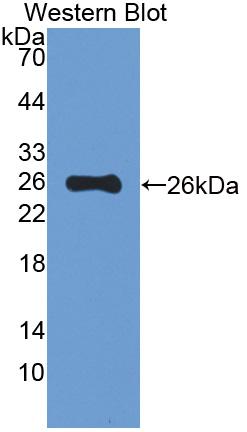FITC-Linked Polyclonal Antibody to Mucin 5 Subtype B (MUC5B) 

MUC5-B; MUC9; MG1; Oligomeric Mucus/Gel-Forming; Mucin 5,Subtype B,Tracheobronchial; Cervical mucin; High molecular weight salivary mucin MG1; Sublingual gland mucin
- UOM
- FOB US$ 121.00 US$ 282.00 US$ 403.00 US$ 1,008.00 US$ 4,030.00
- Quantity
Overview
Properties
- Product No.LAA684Mu81
- Organism SpeciesMus musculus (Mouse) Same name, Different species.
- ApplicationsApplications: WB; IHC; ICC; IP.If the antibody is used in flow cytometry, please check FCM antibodies.
Research use only - DownloadInstruction Manual
- CategoryTumor immunityInfection immunityPulmonologyDermatology
- SourceAntibody labeling
- Ig Type IgG, Potency n/a
- PurificationAntigen-specific affinity chromatography followed by Protein A affinity chromatography
- LabelFITC
- Original Antibody PAA684Mu01-Polyclonal Antibody to Mucin 5 Subtype B (MUC5B)
- Buffer FormulationPBS, pH7.4, containing 0.01% SKL, 1mM DTT, 5% Trehalose and Proclin300.
- TraitsLiquid, Concentration 500µg/mL
Sign into your account
Share a new citation as an author
Upload your experimental result
Review

Contact us
Please fill in the blank.
Specifity
The antibody is a rabbit polyclonal antibody raised against MUC5B. It has been selected for its ability to recognize MUC5B in immunohistochemical staining and western blotting.
Usage
Western blotting: 0.5-2µg/mL
Immunohistochemistry: 5-20µg/mL
Immunocytochemistry: 5-20µg/mL
Optimal working dilutions must be determined by end user.
Storage
Store at 4°C for frequent use. Stored at -20°C in a manual defrost freezer for two year without detectable loss of activity. Avoid repeated freeze-thaw cycles.
Stability
The thermal stability is described by the loss rate. The loss rate was determined by accelerated thermal degradation test, that is, incubate the protein at 37°C for 48h, and no obvious degradation and precipitation were observed. The loss rate is less than 5% within the expiration date under appropriate storage condition.
Giveaways
Increment services
-
 Protein A/G Purification Column
Protein A/G Purification Column
-
 Staining Solution for Cells and Tissue
Staining Solution for Cells and Tissue
-
 Positive Control for Antibody
Positive Control for Antibody
-
 Tissue/Sections Customized Service
Tissue/Sections Customized Service
-
 Phosphorylated Antibody Customized Service
Phosphorylated Antibody Customized Service
-
 Western Blot (WB) Experiment Service
Western Blot (WB) Experiment Service
-
 Immunohistochemistry (IHC) Experiment Service
Immunohistochemistry (IHC) Experiment Service
-
 Immunocytochemistry (ICC) Experiment Service
Immunocytochemistry (ICC) Experiment Service
-
 Flow Cytometry (FCM) Experiment Service
Flow Cytometry (FCM) Experiment Service
-
 Immunoprecipitation (IP) Experiment Service
Immunoprecipitation (IP) Experiment Service
-
 Immunofluorescence (IF) Experiment Service
Immunofluorescence (IF) Experiment Service
-
 Buffer
Buffer
-
 DAB Chromogen Kit
DAB Chromogen Kit
-
 SABC Kit
SABC Kit
-
 Real Time PCR Experimental Service
Real Time PCR Experimental Service
Citations
- The Extracellular Signal-regulated Kinase Mitogen-activated Protein Kinase/Ribosomal S6 Protein Kinase 1 Cascade Phosphorylates cAMP Response Element-binding Protein to Induce MUC5B Gene Expression via D-Prostanoid Receptor SignalingJcb: 34199
- The ERK MAPK/RSK1 cascade phosphorylates CREB to induce MUC5B gene expression via DP1 receptor signalingJcb: 247684
- Pyocyanin-induced mucin production is associated with redox modification of FOXA2PubMed: PMC3765780
- Secreted mucins and airway bacterial colonization in non-CF bronchiectasisPubMed: 26172851
- Mucin Secretion In Asthmatics With Osmotic Airway Hyperresponsivenessdoi:10.1164
- Airway Mucin 2 Is Decreased in Patients with Severe Chronic Obstructive Pulmonary Disease with Bacterial Colonizationdoi:10.1513
- Секреторно-экссудативная реакция слизистой носа на воздействие холодного воздуха у больных бронхиальной астмой10.20538/1682-0363-2017-2-146-158
- Th2 cytokines orchestrate the secretion of MUC 5 AC and MUC 5B in IL‐5 positive chronic rhinosinusitis with nasal polypsPubmed:29802623
- Salvianolic acid B improves airway hyperresponsiveness by inhibiting MUC5AC overproduction associated with Erk1/2/P38 signalingPubmed:29382534
- インフルエンザ菌Phosphorylcholine の表出と中耳ムチンMUC5AC 及びMUC5B 産生への影響10.5648:jjiao.36.7
- The characteristics and clinical significance of mucin levels in bronchoalveolar lavage fluid of patients with interstitial lung diseasePubmed: 30573494
- ASC and NLRP3 maintain innate immune homeostasis in the airway through an inflammasome-independent mechanismPubmed: 31278375






